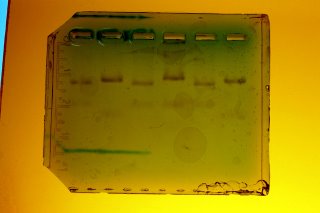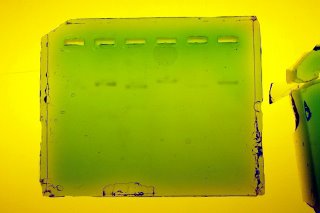The link I included to the Deep Sea News blog a few posts ago has been noticed by the scientists who run it and have officially welcomed our class via a blog entry there. You should check it out and take advantage of the spirit of cooperation and interactivity that these blogs give us.
Here's their link again:
Deep Sea News
(scroll down a bit to find the 'Welcome Attleboro' post)
Saturday, December 30, 2006
Friday, December 22, 2006
(most of) Your Gels
Not my best photographic work, but here you go. I tweaked them a bit in Photoshop to better bring out the set of second bands. Click on the photos for a larger image.










Where do plants come from?
We've been discussing in class a bit how we as a society are able to genetically engineer organisms - a technology that has taken hold over the past 30 years or so. But the natural world has been genetically engineering for millenia - not with anything technological or with that high a success rate, but effective nonetheless. We've mentioned earlier in the year how chloroplasts and mitochondria are believed to have evolved from prokaryotes that were engulfed by larger single-celled organisms - a process called endosymbiosis. Quite an amazing feat - esssentially harnessing the genetic power of one organism to help you survive. It was long believed that the evolution of algae and plants all stemmed from a single endosymbiotic event and that all chloroplasts share a common ancestor some 500 million years ago. But new research has shown that this may not be the case. By sequencing and comparing the genomes (full genetic makeup) of various chloroplasts (remember that chloroplasts and mitochondria have their own DNA) researchers have discovered that there were likely at least two independent endosymiotic events that lead to chloroplasts. This has many implications, including the idea that if this sort of thing can happen twice, why not more. And if it has happened more than once, what does this mean about the origin and evolution of the various photosynthetic organisms around today?
As a side note, this article/research is a good example of a branch of biology that studies the very early branches of the tree of life - basically delving back 100s of millions of years to examine how life emerged. Interesting, but difficult work.
Delving Into Chloroplasts' Past
Wednesday, December 20, 2006
Sea of Life: part II
For those of you interested in marine biology check out the following blog on the deep sea. I especially like the "25 things you need to know about the deep sea" series.
Deep Sea News
(actually, a lot of the blogs housed over at ScienceBlogs.com are pretty good)
Deep Sea News
(actually, a lot of the blogs housed over at ScienceBlogs.com are pretty good)
Tuesday, December 19, 2006
Genetically Modified Organisms
Genetically modified plants and animals are becoming more and more common in our lives. Some are purely designed to help scientists more easily study some aspect of biology while others are important for their medicinal or food value. The image here is a picture of grains of golden rice - the rice strain that has been genetically engineered to produce beta-carotene presumably to make it more nutritious, though others argue that it is nothing more than a marketing scheme. There are a lot of concerns around Genetically Modified Organisms (GMOs) and like just about anything there are pros and cons that need to be considered when deciding whether we should proceed in a certain direction with GMOs. To help you learn more about GMOs and the science behind them here are a few links:
WikiPedia article on genetic engineering - a good general article
New Scientist - this section of this website is dedicated to all things concerning GMOs. Scroll down to see an list of about a billion news articles on GMOs (well, maybe only a million).
Monday, December 11, 2006
Sea of Life
Here's an interesting article that highlights some of the marine research that was done this past year. It's amazing how much we still have to learn about the natural world - just when people think we couldn't possibly discover anything more, up pops a shrimp thought extinct for 50 million year or schools of fish 20 million strong. Amazing stuff.
Census of seas reveals amazing forms of life
Friday, December 08, 2006
Tuesday, December 05, 2006
Virtual Fly Lab
For those interested in playing around in the virtual world of fruit fly genetics, here's the link:
Virtual Fly Lab
I'm also interested in hearing whether or not you found the site and the activities interesting and/or helpful.
UPDATE: want to order your own Drosophila? Check this out.
Monday, December 04, 2006
Is That a Fungus In Your Brain?
this video is really just too cool - a parasitic mushroom that takes control of an insect's brain.
video here
Friday, December 01, 2006
Inner Life of Cells - Part II
Here's the link to the extended version of The Inner Life of Cells. This is the full-length version that does not have the cool music, but does have a narration explaining everything. It is really rather dry - even I am am having a hard time watching the whole thing - but is it interesting to hear the various components explained.
Inner Life of Cells
(when you follow the link you'll need to wait a few seconds before the Harvard copyright warning gives way to the video)